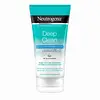What's inside
What's inside
 Key Ingredients
Key Ingredients

 Benefits
Benefits

 Concerns
Concerns

 Ingredients Side-by-side
Ingredients Side-by-side

Water
Skin ConditioningSodium C14-16 Olefin Sulfonate
CleansingCocamidopropyl Hydroxysultaine
CleansingCellulose
AbsorbentSorbitol
HumectantAcrylates Crosspolymer-4
Emulsion StabilisingSodium Hydrolyzed Potato Starch Dodecenylsuccinate
Cera Microcristallina
Emulsion StabilisingSalicylic Acid
MaskingDisodium Tetrapropenyl Succinate
Menthol
MaskingPolysorbate 20
EmulsifyingSodium Chloride
MaskingDisodium EDTA
Citric Acid
BufferingGlycolic Acid
BufferingSodium Hydroxide
BufferingParfum
MaskingCI 77510
Cosmetic ColorantCI 42053
Cosmetic ColorantWater, Sodium C14-16 Olefin Sulfonate, Cocamidopropyl Hydroxysultaine, Cellulose, Sorbitol, Acrylates Crosspolymer-4, Sodium Hydrolyzed Potato Starch Dodecenylsuccinate, Cera Microcristallina, Salicylic Acid, Disodium Tetrapropenyl Succinate, Menthol, Polysorbate 20, Sodium Chloride, Disodium EDTA, Citric Acid, Glycolic Acid, Sodium Hydroxide, Parfum, CI 77510, CI 42053
Water
Skin ConditioningSodium Carboxymethyl Starch
Emulsion StabilisingSodium Lactate
BufferingButylene Glycol
HumectantGluconolactone
Skin ConditioningDecyl Glucoside
CleansingLauryl Glucoside
CleansingMaltooligosyl Glucoside
Skin ConditioningHydrogenated Starch Hydrolysate
HumectantAloe Barbadensis Leaf Juice
Skin ConditioningPanthenol
Skin ConditioningLactic Acid
BufferingCocamidopropyl Betaine
CleansingInulin
Skin ConditioningXanthan Gum
EmulsifyingCitric Acid
BufferingSodium Benzoate
MaskingWater, Sodium Carboxymethyl Starch, Sodium Lactate, Butylene Glycol, Gluconolactone, Decyl Glucoside, Lauryl Glucoside, Maltooligosyl Glucoside, Hydrogenated Starch Hydrolysate, Aloe Barbadensis Leaf Juice, Panthenol, Lactic Acid, Cocamidopropyl Betaine, Inulin, Xanthan Gum, Citric Acid, Sodium Benzoate
Ingredients Explained
These ingredients are found in both products.
Ingredients higher up in an ingredient list are typically present in a larger amount.
Citric Acid is an alpha hydroxy acid (AHA) naturally found in citrus fruits like oranges, lemons, and limes.
Like other AHAs, citric acid can exfoliate skin by breaking down the bonds that hold dead skin cells together. This helps reveal smoother and brighter skin underneath.
However, this exfoliating effect only happens at high concentrations (20%) which can be hard to find in cosmetic products.
Due to this, citric acid is usually included in small amounts as a pH adjuster. This helps keep products slightly more acidic and compatible with skin's natural pH.
In skincare formulas, citric acid can:
While it can provide some skin benefits, research shows lactic acid and glycolic acid are generally more effective and less irritating exfoliants.
Most citric acid used in skincare today is made by fermenting sugars (usually from molasses). This synthetic version is identical to the natural citrus form but easier to stabilize and use in formulations.
Read more about some other popular AHA's here:
Learn more about Citric AcidWater. It's the most common cosmetic ingredient of all. You'll usually see it at the top of ingredient lists, meaning that it makes up the largest part of the product.
So why is it so popular? Water most often acts as a solvent - this means that it helps dissolve other ingredients into the formulation.
You'll also recognize water as that liquid we all need to stay alive. If you see this, drink a glass of water. Stay hydrated!
Learn more about Water